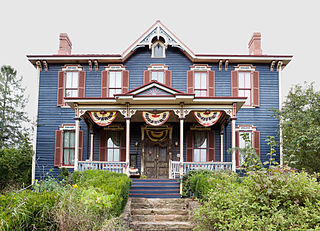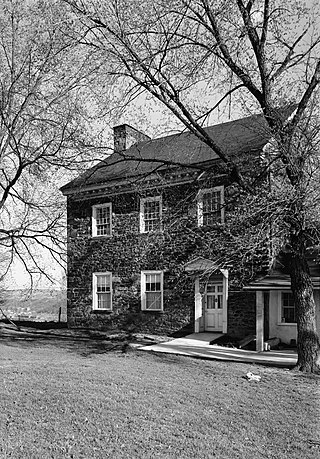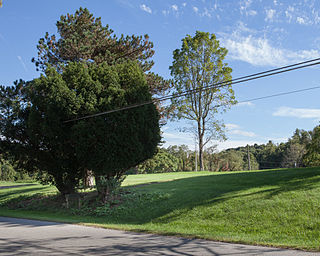
The National Road was the first major improved highway in the United States built by the federal government. Built between 1811 and 1837, the 620-mile (1,000 km) road connected the Potomac and Ohio Rivers and was a main transport path to the West for thousands of settlers. When improved in the 1830s, it became the second U.S. road surfaced with the macadam process pioneered by Scotsman John Loudon McAdam.

Brownsville is a borough in Fayette County, Pennsylvania, United States, first settled in 1785 as the site of a trading post a few years after the defeat of the Iroquois enabled a resumption of westward migration after the Revolutionary War. The trading post soon became a tavern and inn and was receiving emigrants heading west, as it was located above the cut bank overlooking the first ford that could be reached to those descending from the Allegheny Mountains. Brownsville is located 40 miles (64 km) south of Pittsburgh along the east bank of the Monongahela River.

West Brownsville is a former important transportation nexus and a present-day borough in Washington County, Pennsylvania, United States and part of the Pittsburgh metropolitan area. The population was 972 at the 2020 census. Culturally, by postal route, and socially, the community is connected to cross-river sister-city Brownsville, for the two were long joined by the Amerindian trail known as Nemacolin's Path that became a wagon road after the American Revolution, but West Brownsville is a separate municipality. Brownsville was the first point where the descent from the Appalachians could safely reach the river down the generally steep banks of the Monongahela River. Between Brownsville and West Brownsville was a shallow stretch, usable as a river ford astride a major Emigrant Trail to the various attractive regions in the Northwest Territory, the first National Road, the Cumberland Pike.

The Edward G. Acheson House is a historic house at 908 West Main St. in Monongahela, Washington County, Pennsylvania, United States. Probably built about 1870, it is notable as the home of Edward G. Acheson (1856-1931), the inventor of carborundum, and as the likely site of its invention. It was designated a National Historic Landmark in 1976.

The Brownsville Bridge, also known as the Intercounty Bridge and the West Brownsville Bridge, is a truss bridge that carries vehicular traffic across the Monongahela River between Brownsville, Pennsylvania and West Brownsville, Pennsylvania. Since the opening of the Lane Bane Bridge and highway project to carry much of the intercounty through traffic away from the main streets of downtown Brownsville in the early 1960s, another commonly heard name is Old Brownsville Bridge for the four high level viaduct.

The Dr. Joseph Maurer House is a historic house in Washington, Pennsylvania.

The James Thome Farm is a historic farm located in Eighty Four, Pennsylvania. It was designated as a historic residential landmark/farmstead by the Washington County History & Landmarks Foundation, and is listed on the National Register of Historic Places.

The Martin Farmstead is a historic building in Washington, Pennsylvania.

Samuel Brownlee House is a historic building in Washington, Pennsylvania. It is designated as a historic residential landmark/farmstead by the Washington County History & Landmarks Foundation.

Joseph Dorsey House was a historic building in West Brownsville, Pennsylvania. It is designated as a historic residential landmark/farmstead by the Washington County History & Landmarks Foundation.

Centerville Historic District is a historic district in Centerville, Pennsylvania. Centerville represents an intact example of the "pike town" typical of the National Road in Pennsylvania. Little commercial activity remains in the town today, but the ninety-four contributing buildings in the district includes taverns, residences, shops, and services buildings typical of the rise and decline of the National Road.

Dager-Wonsettler Farmstead is a historic building in Glyde, Pennsylvania. It is designated as a historic residential landmark/farmstead by the Washington County History & Landmarks Foundation.

The Harrison House was an historic building which was located in Centerville, Pennsylvania.

The Huffman Distillery and Chopping Mill is an historic complex of buildings which is located in Somerset Township, Washington County, Pennsylvania, United States.

David Longwell House is a historic building in Monongahela, Pennsylvania.

Robert Parkinson Farm is a historic property located in Morris Township, Pennsylvania, United States.

Ringland Tavern is a historic building in Scenery Hill, Pennsylvania.

Ulery Mill was a historic building in Marianna, Pennsylvania, United States. It has been demolished.

Levi Wilson Tavern is a historic building in Buffalo Township, Pennsylvania

The unincorporated hamlet of Malden is a bedroom community that is located on the historic 'Old National Pike' in borough of Centerville Washington County, Pennsylvania. Originally an early wagon stop in rural Pennsylvania, it became a small transportation hub during the surge of westward migration to the Northwest Territory after 1790.
























